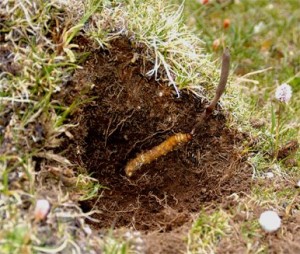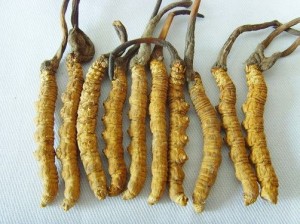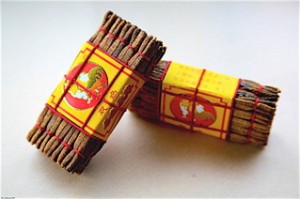Medicinal Mushrooms Cordyceps, the Energetic One

Cordyceps, in its many forms, has been used since the 15th century in China and Tibet, while also being used by indigenous peoples around the world.1,2 I have seen it growing in diverse places like China and the Amazon. Its Chinese name dong chong xia cao literally means “winter bug, summer herb,” a reference to the fact that it is an insect in the winter and the mature fungus is harvested the following year.
This mushroom was basically unknown in the Western world until it attracted the attention of the general public and the health profession in 1993, when a group of female Chinese runners started a winning streak, breaking nine world records in the outdoor Track and Field. Afterwards the coach (Ma Junren) attributed those results to the athletes’ regular use of a Cordyceps based tonic. It is now used by both Olympian and professional athletes worldwide. It is not restricted from international competition as an athletic enhancing substance, because it is considered a food.3 Here is another example of mushrooms being Super Foods.

I first noticed Cordyceps while exploring in the exotic section of a specialty herb shop in China Town in the mid 1980’s. A small block of these caterpillar-like mushrooms was selling for a little over $2,000. Not something that I could use with my usual patient. I kept my eye on them as they intrigued me. The price of wild Cordyceps is still on an ever increasing cost curve, with a kilogram at wholesale price costing $15,000 to $30,000. Why would anyone want to pay that much for some mushrooms?
 Cordyceps is a renowned aphrodisiac, with promising scientific research.
Cordyceps is a renowned aphrodisiac, with promising scientific research.
Anti-aging, memory and fatigue
Respiratory tract, working as a bronchial dilator; used by athletes, it aids in both getting more oxygen into the cells and increasing endurance.
Works against some forms of Diabetes, beneficial for insulin resistance.
In cancer, 1 inhibits the production of DNA and RNA synthesis in cancer cells,enhancement of cell differentiation, restructuring of cytoskeleton in cells, inhibition of protein kinase activity, antitumor activity on bladder, kidney, colon, lung carcinoma as well as fibroblastoma
Protects as a conjunctive therapy to increase tolerance to both radiation and chemotherapy in cancer.
Cardiovascular Health: reduced heart rate and restoration from arrhythmias have also been shown in animals. Long-term clinical studies in cardiac failure have described Cordyceps’ effect in improving cardiac function, arrhythmias, and overall quality of life. Platelet aggregation has been inhibited in rabbits and in human platelets in vitro.
Anti-depressant
Promotes cellular health
Regulates blood lipids
Protects the Liver from cirrhosis and hepatitis
Inhibition of infection and reverse transcriptase activity of HIV
Increases both male and female fertility
Several studies show increased immune function while consuming
Increases the size of the spleen; decreases the size of the thymus
The wild Cordyceps grows on the bodies of insects making it both exotic and rare. Because natural Cordyceps (wild Cordyceps sinensis) is so rare, Chinese scientists have extensively examined its life cycle with the aim of developing a technique for isolating fermentable strains of Cordyceps sinensis. At the Institute of Materia Medica, Chinese Academy of Medical Sciences, the strain Cs-4 was isolated from wild Cordyceps sinensis Cs-4 has been used to produce a fermented product of the mycelia of Paecilomyces hepiali. It contains the same pharmacologically active components as the natural Cordyceps. Since its successful isolation in 1982, the Cs4 fermentation product has been studied intensively in China. This cloned product is not only more economical, it leaves the wild species in a more sustainable habitat, something of great political/economical and environmental concern over the last 10 years. Recent studies have shown not only are many of the constituents the same between the two, the genetics (sequence of rDNA-ITS) is 87 – 100% the same as the wild species.53 Most of the scientific studies are based on this fermented variety.54 Of course this product is much more economical, to be affordable by most people.
Cordyceps has a strong tonic effect, increasing oxygen uptake in the lungs by opening up the bronchial tubes, while reducing bronchial inflammation and working as an expectorant. It is well known to relieve exhaustion, night sweats, sexual impotency and for its function as a sedative. Cordyceps will increase immune function, anti-tumor function, reduce cholesterol (beneficially adjusting HDL/LDL ratio) and plasma triglycerides; as well as increasing spermatogenesis and sex drive. Other conditions it benefits include improvement in arrhythmias, chronic kidney problems, liver function after hepatitis B, and tinnitus.
Cordyceps is specific for uterine fibroids. It will stimulate immune function (due to CS-1) by activating T-cells and B-cells, while increasing interleukin-1 (but not 2) and gamma-interferon. It has also been shown to increase erythroid progenitor cells and erythroid colony-forming units in bone marrow. Sedative and even hypnotic activity can be attributed to the amino acid content.
The therapeutic effects of this extraordinary mushroom have been confirmed in many controlled and well designed studies carried out by many medical schools. There are literally hundreds of scientific papers written on this fungus over the last ten years.
Both natural Cordyceps and cultured mycelia of C. sinensis have significant effects on the immune systems of mice. They can increase the size of the spleen, decrease the size of the thymus, and prevent atrophy of spleen and liver and hypertrophy of the thymus in mice induced by cyclophosphamide.55 The DNA, RNA, and protein contents in the enlarged spleen were significantly increased.

Cordyceps, in its many forms, has been used since the 15th century in China and Tibet, while also being used by indigenous peoples around the world.1,2 I have seen it growing in diverse places like China and the Amazon. Its Chinese name dong chong xia cao literally means “winter bug, summer herb,” a reference to the fact that it is an insect in the winter and the mature fungus is harvested the following year.
This mushroom was basically unknown in the Western world until it attracted the attention of the general public and the health profession in 1993, when a group of female Chinese runners started a winning streak, breaking nine world records in the outdoor Track and Field. Afterwards the coach (Ma Junren) attributed those results to the athletes’ regular use of a Cordyceps based tonic. It is now used by both Olympian and professional athletes worldwide. It is not restricted from international competition as an athletic enhancing substance, because it is considered a food.3 Here is another example of mushrooms being Super Foods.

I first noticed Cordyceps while exploring in the exotic section of a specialty herb shop in China Town in the mid 1980’s. A small block of these caterpillar-like mushrooms was selling for a little over $2,000. Not something that I could use with my usual patient. I kept my eye on them as they intrigued me. The price of wild Cordyceps is still on an ever increasing cost curve, with a kilogram at wholesale price costing $15,000 to $30,000. Why would anyone want to pay that much for some mushrooms?
 Cordyceps is a renowned aphrodisiac, with promising scientific research.
Cordyceps is a renowned aphrodisiac, with promising scientific research.Anti-aging, memory and fatigue
Respiratory tract, working as a bronchial dilator; used by athletes, it aids in both getting more oxygen into the cells and increasing endurance.
Works against some forms of Diabetes, beneficial for insulin resistance.
In cancer, 1 inhibits the production of DNA and RNA synthesis in cancer cells,enhancement of cell differentiation, restructuring of cytoskeleton in cells, inhibition of protein kinase activity, antitumor activity on bladder, kidney, colon, lung carcinoma as well as fibroblastoma
Protects as a conjunctive therapy to increase tolerance to both radiation and chemotherapy in cancer.
Cardiovascular Health: reduced heart rate and restoration from arrhythmias have also been shown in animals. Long-term clinical studies in cardiac failure have described Cordyceps’ effect in improving cardiac function, arrhythmias, and overall quality of life. Platelet aggregation has been inhibited in rabbits and in human platelets in vitro.
Anti-depressant
Promotes cellular health
Regulates blood lipids
Protects the Liver from cirrhosis and hepatitis
Inhibition of infection and reverse transcriptase activity of HIV
Increases both male and female fertility
Several studies show increased immune function while consuming
Increases the size of the spleen; decreases the size of the thymus
The wild Cordyceps grows on the bodies of insects making it both exotic and rare. Because natural Cordyceps (wild Cordyceps sinensis) is so rare, Chinese scientists have extensively examined its life cycle with the aim of developing a technique for isolating fermentable strains of Cordyceps sinensis. At the Institute of Materia Medica, Chinese Academy of Medical Sciences, the strain Cs-4 was isolated from wild Cordyceps sinensis Cs-4 has been used to produce a fermented product of the mycelia of Paecilomyces hepiali. It contains the same pharmacologically active components as the natural Cordyceps. Since its successful isolation in 1982, the Cs4 fermentation product has been studied intensively in China. This cloned product is not only more economical, it leaves the wild species in a more sustainable habitat, something of great political/economical and environmental concern over the last 10 years. Recent studies have shown not only are many of the constituents the same between the two, the genetics (sequence of rDNA-ITS) is 87 – 100% the same as the wild species.53 Most of the scientific studies are based on this fermented variety.54 Of course this product is much more economical, to be affordable by most people.
Cordyceps has a strong tonic effect, increasing oxygen uptake in the lungs by opening up the bronchial tubes, while reducing bronchial inflammation and working as an expectorant. It is well known to relieve exhaustion, night sweats, sexual impotency and for its function as a sedative. Cordyceps will increase immune function, anti-tumor function, reduce cholesterol (beneficially adjusting HDL/LDL ratio) and plasma triglycerides; as well as increasing spermatogenesis and sex drive. Other conditions it benefits include improvement in arrhythmias, chronic kidney problems, liver function after hepatitis B, and tinnitus.
Cordyceps is specific for uterine fibroids. It will stimulate immune function (due to CS-1) by activating T-cells and B-cells, while increasing interleukin-1 (but not 2) and gamma-interferon. It has also been shown to increase erythroid progenitor cells and erythroid colony-forming units in bone marrow. Sedative and even hypnotic activity can be attributed to the amino acid content.
The therapeutic effects of this extraordinary mushroom have been confirmed in many controlled and well designed studies carried out by many medical schools. There are literally hundreds of scientific papers written on this fungus over the last ten years.
Both natural Cordyceps and cultured mycelia of C. sinensis have significant effects on the immune systems of mice. They can increase the size of the spleen, decrease the size of the thymus, and prevent atrophy of spleen and liver and hypertrophy of the thymus in mice induced by cyclophosphamide.55 The DNA, RNA, and protein contents in the enlarged spleen were significantly increased.

No comments:
Post a Comment